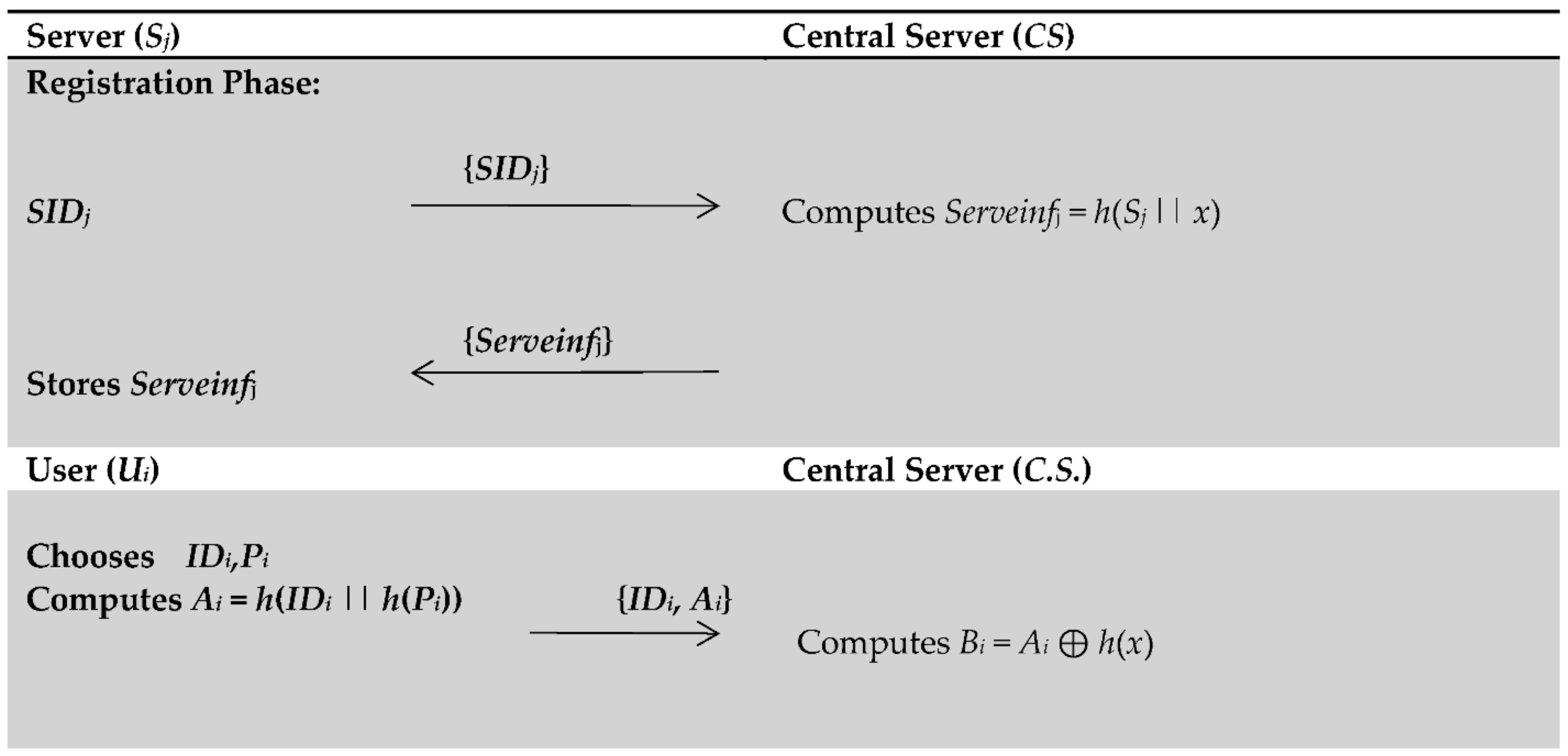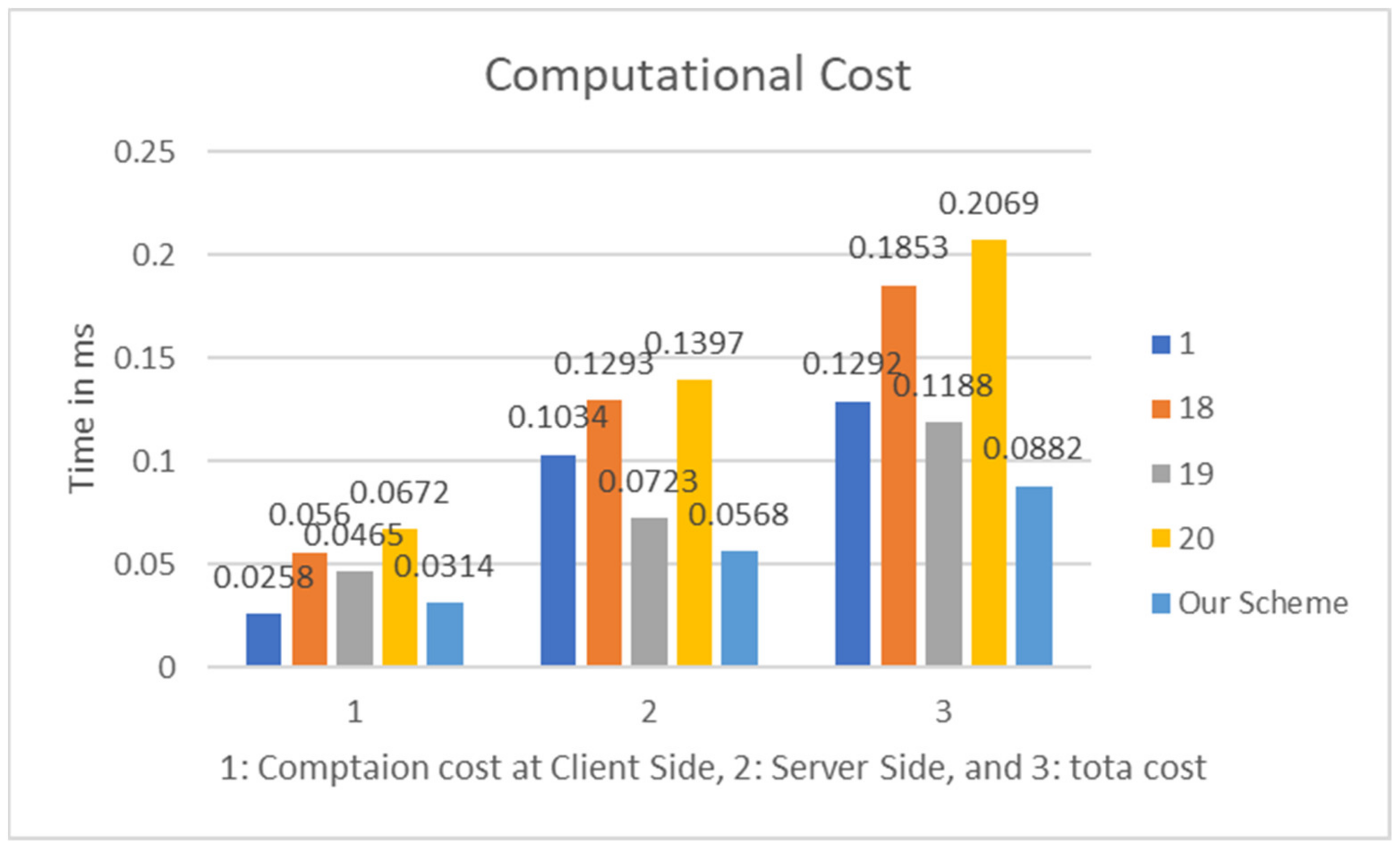A Secure Authentication Scheme for Teleservices Using Multi-Server Architecture
Abstract
:1. Introduction
- ▪
- In a review of Jin Kewak scheme, it suffers from various attacks.
- ▪
- We propose an improved version of Jin Kewak scheme.
- ▪
- The proposed scheme has essential features of the authentication scheme, such as user anonymity and mutual authentication, and is free from various security attacks, including user impersonation attacks, offline password guessing attacks, replay attacks, and insider attacks.
- ▪
2. Related Work
3. Crypto Analysis of Jin Kwak’s Dynamic-Identity-Based Scheme [1]
- (1)
- An adversary, who may take control of the communication channel as the channel is public, may perform an inserting or listening operation.
- (2)
- An adversary may get the lost smart card.
- (3)
- An adversary may obtain the stored parameters by analyzing the card’s power consumption.
3.1. User Impersonation Attack
3.2. Replay Attack
3.3. Insider Attack
4. Proposed Authentication Protocol
4.1. Registration Phase
4.2. Registration Phase
4.3. Log-In and Authentication Phase
4.4. Password Change Phase
5. Security Analysis of Our Scheme
5.1. Free from an Insider Attack
5.2. Resists Online Password Guessing Attack
5.3. Resists Offline Password Guessing Attack
5.4. Resists User Impersonation
5.5. Resists Server Masquerading Attack
5.6. Resists Replay Attack
5.7. Resists Stolen Verifier Attack
6. Performance and Efficiency Comparison
7. Conclusions
Author Contributions
Funding
Institutional Review Board Statement
Informed Consent Statement
Data Availability Statement
Conflicts of Interest
References
- Bae, W.-I.; Kwak, J. Smart card-based secure authentication protocol in multi-server IoT environment. Multimed. Tools Appl. 2017, 79, 15793–15811. [Google Scholar] [CrossRef]
- Odelu, V.; Das, A.K.; Goswami, A. A Secure Biometrics-Based Multi-Server Authentication Protocol Using Smart Cards. IEEE Trans. Inf. Forensics Secur. 2015, 10, 1953–1966. [Google Scholar] [CrossRef]
- Kumari, S.; Khan, M.K.; Li, X. An improved remote user authentication scheme with key agreement. Comput. Electr. Eng. 2014, 40, 1997–2012. [Google Scholar] [CrossRef]
- Sethi, P.; Sarangi, S.R. Internet of Things: Architectures, Protocols, and Applications. J. Electr. Comput. Eng. 2017, 25, 9324035. [Google Scholar] [CrossRef]
- Sood, S.; Sarje, A.K.; Singh, K.D. A secure dynamic identity based authentication protocol for multi-server architecture. J. Netw. Comput. Appl. 2011, 34, 609–618. [Google Scholar] [CrossRef]
- Maitra, T.; Islam, S.H.; Amin, R.; Giri, D.; Khan, M.K.; Kumar, N. An enhanced multi-server authentication protocol using password and smart-card: Cryptanalysis and design. Secur. Commun. Netw. 2016, 9, 4615–4638. [Google Scholar] [CrossRef]
- El-Emam, E.; Koutb, M.; Kelash, H.M.; Faragallah, O.S. An Authentication Protocol Based on Kerberos 5. I. J. Netw. Secur. 2011, 12, 159–170. [Google Scholar]
- GSMA Report Shows 5G Coverage is Set to Accelerate Across Asia Pacific—But the Usage Gap Remains Significant. Available online: https://www.gsma.com/newsroom/press-release/gsma-report-shows-5g-coverage-is-set-to-accelerate-across-asia-pacific-but-the-usage-gap-remains-significant/ (accessed on 30 July 2022).
- Hwang, M.-S.; Chong, S.-K.; Chen, T.-Y. DoS-resistant ID-based password authentication scheme using smart cards. J. Syst. Softw. 2010, 83, 163–172. [Google Scholar] [CrossRef]
- Seth, J.K.; Kumar, S.; Chandra, S. Nophish: A Phish Detector in Cloud services. Telecommun. Radio Eng. 2018, 77, 1055–1069. [Google Scholar] [CrossRef]
- Chang, C.; Wu, H.; Wang, Z.; Mao, Q. An Efficient Smart Card Based Authentication Scheme Using Image Encryption. J. Inf. Sci. Eng. 2013, 29, 1135–1150. [Google Scholar]
- Kumar, S.; Singh, V.; Sharma, V.; Singh, V.P. Advance remote user authentication scheme using smart card. Telecommun. Radio Eng. 2019, 78, 957–971. [Google Scholar] [CrossRef]
- Messerges, T.; Dabbish, E.; Sloan, R. Examining smart-card security under the threat of power analysis attacks. IEEE Trans. Comput. 2002, 51, 541–552. [Google Scholar] [CrossRef] [Green Version]
- Amin, R.; Islam, S.H.; Karati, A.; Biswas, G.P. Design of an enhanced authentication protocol and its verification using AVISPA. In Proceedings of the 2016 3rd International Conference on Recent Advances in Information Technology (RAIT), Dhanbad, India, 3–5 March 2016; pp. 404–409. [Google Scholar]
- Zhao, Y.; Li, S.; Jiang, L. Secure and Efficient User Authentication Scheme Based on Password and Smart Card for Multiserver Environment. Secur. Commun. Netw. 2018, 2018, 9178941. [Google Scholar] [CrossRef]
- Chen, C.M.; Chen, L.; Huang, Y.; Kumar, S.; Wu, J.M.T. Lightweight authentication protocol in edge-based smart grid environment. J Wireless Com Netw. 2021, 68. [Google Scholar] [CrossRef]
- Wang, H.; Guo, D.; Wen, Q.; Zhang, H. A Robust Authentication Scheme for Multiple Servers Architecture. IEEE Access 2019, 7, 111222–111231. [Google Scholar] [CrossRef]
- Wu, F.; Li, X.; Xu, L.; Sangaiah, A.K.; Rodrigues, J.J. Authentication Protocol for Distributed Cloud Computing: An Explanation of the Security Situations for Internet-of-Things-Enabled Devices. IEEE Consum. Electron. Mag. 2018, 7, 38–44. [Google Scholar] [CrossRef]
- Amin, N.R.; Kumar, G.; Biswas, R.; Iqbal; Chang, V. A light weight authentication protocol for IoT-enabled devices in distributed cloud com puting environment. Future Gener Comput. Syst. 2018, 78, 1005–1019. [Google Scholar] [CrossRef]
- Wu, T.-Y.; Lee, Z.; Obaidat, M.S.; Kumari, S.; Kumar, S.; Chen, C.-M. An Authenticated Key Exchange Protocol for Multi-Server Architecture in 5G Networks. IEEE Access 2020, 8, 28096–28108. [Google Scholar] [CrossRef]
- Thorwat, P.D.; Shetty, S.A. Implementation of Multilevel Authentication Scheme for Multicloud Environment. Int. J. Comput. Appl. 2014, 975, 8887. [Google Scholar]
- Martínez-Peláez, R.; Toral-Cruz, H.; Parra-Michel, J.R.; García, V.; Mena, L.J.; Felix, V.G.; Ochoa-Brust, A.M. An Enhanced Lightweight IoT-based Authentication Scheme in Cloud Computing Circumstances. Sensors 2019, 19, 2098. [Google Scholar] [CrossRef]
- Renuka, K.; Kumar, S.; Kumari, S.; Chen, C.-M. Cryptanalysis and Improvement of a Privacy-Preserving Three-Factor Authentication Protocol for Wireless Sensor Networks. Sensors 2019, 19, 4625. [Google Scholar] [CrossRef] [PubMed]
- Kumar, A.; Om, H. An improved and secure multi-server authentication scheme based on biometrics and smartcard. Digit. Commun. Netw. 2017, 4, 27–38. [Google Scholar] [CrossRef]
- Li, J.; Peng, Z.; Gao, S.; Xiao, B.; Chan, H. Smartphone-assisted energy efficient data communication for wearable devices. Comput. Commun. 2017, 105, 33–43. [Google Scholar] [CrossRef]
- Li, J.; Peng, Z.; Xiao, B. Smartphone-assisted smooth live video broadcast on wearable cameras. In Proceedings of the 2016 IEEE/ACM 24th International Symposium on Quality of Service (IWQoS), Beijing, China, 20–21 June 2016; pp. 1–6. [Google Scholar] [CrossRef]
- Yao, Y.; Peng, Z.; Xiao, B.; Guan, J. An efficient learning-based approach to multi-objective route planning in a smart city. In Proceedings of the 2017 IEEE International Conference on Communications (ICC), Paris, France, 21–25 May 2017; pp. 1–6. [Google Scholar] [CrossRef]
- Kumar, S.; Baliyan, A.; Tiwari, A.; Tripathi, A.K.; Jaiswal, B. Intelligent traffic controller. Int. J. Inf. Technol. 2019, 14, 2141–2153. [Google Scholar] [CrossRef]
- Xujing, Z.-T.; Guo, F. An improved smart card based password authentication scheme with provable security. Comput. Stand. Interfaces 2009, 31, 723–728. [Google Scholar]
- Kocher, P.C.; Jaffe, J.; Jun, B. Differential Power Analysis. In Annual International Cryptology Conference; Springer: Berlin/Heidelberg, Germany, 1999. [Google Scholar]




| Notation | Description |
|---|---|
| Ui | The ith User |
| Sj | The jth server |
| CS | The Central server for authentication |
| Idi | The identity of the user i |
| Pi | The used password |
| UIDi | The anonymous identity of the user i |
| SIDj | The identity of SIDj |
| X | The central server’s master key |
| TS | The used timestamp |
| Ni1 | The random number used by the smart card |
| Ni2 | The random number used by the server Sj |
| Ni3 | The random number used by the Center server |
| SK | Session key among all the parties |
| h(*) | Used hash function, the one-way collision-free hash function |
| ⊕ | Exclusive or gate operation |
| || | The concatenation operation used to concatenate two strings |
| Notation | Description |
|---|---|
| Ui | The ith User |
| Sj | The jth server |
| CS | The Central server for authentication |
| Idi | The identity of the user i |
| Pi | The used password |
| UIDi | The anonymous identity of the user i |
| SIDj | The identity of SIDj |
| X | The central server’s master key |
| TS | The used timestamp |
| Ni1 | The random number used by the smart card |
| SK | Session key among all the parties |
| h(*) | Used hash function, the one-way collision-free hash function |
| ⊕ | Exclusive or gate operation |
| || | The concatenation operation used to concatenate two strings |
| digsig(CS) | Digital Signature of Central Server |
| Schemes→ ↓Security Characteristics | [1] | [18] | [19] | [20] | Our Proposed Scheme |
|---|---|---|---|---|---|
| User Anonymity | Yes | Yes | No | Yes | Yes |
| Mutual Authentication | Yes | Yes | Yes | Yes | Yes |
| User impersonation attack | Yes | Yes | Yes | No | No |
| Offline Password Guessing Attack | No | No | Yes | No | No |
| Replay attack | Yes | No | No | No | No |
| Server impersonation attack | No | No | No | No | No |
| Insider Attack | Yes | No | No | No | No |
| Computation Cost | [1] | [18] | [19] | [20] | Our Proposed Scheme |
|---|---|---|---|---|---|
| Operations on the User side | 5T′/0.0258 | 11T′/0.056 | 9T′/0.0465 | T′/0.0672 | 4T′ + 1T″/0.0314 |
| Operation on the Server side | 20T′/0.1034 | 25T′/0.1293 | 14T′/0.0723 | 27T′/0.1397 | 8T′ + 1T″ + 2T‴/0.0568 |
| Total | 25T′/0.1292 | 36T′/0.1853 | 23T′/0.1188 | 40T′/0.2069 | 12T′ + 2T″ + 2T″/0.0882 |
Publisher’s Note: MDPI stays neutral with regard to jurisdictional claims in published maps and institutional affiliations. |
© 2022 by the authors. Licensee MDPI, Basel, Switzerland. This article is an open access article distributed under the terms and conditions of the Creative Commons Attribution (CC BY) license (https://creativecommons.org/licenses/by/4.0/).
Share and Cite
Kumar, S.; Agarwal, K.; Gupta, A.K.; Kumari, S.; Sain, M. A Secure Authentication Scheme for Teleservices Using Multi-Server Architecture. Electronics 2022, 11, 2839. https://doi.org/10.3390/electronics11182839
Kumar S, Agarwal K, Gupta AK, Kumari S, Sain M. A Secure Authentication Scheme for Teleservices Using Multi-Server Architecture. Electronics. 2022; 11(18):2839. https://doi.org/10.3390/electronics11182839
Chicago/Turabian StyleKumar, Sachin, Kadambri Agarwal, Amit Kumar Gupta, Saru Kumari, and Mangal Sain. 2022. "A Secure Authentication Scheme for Teleservices Using Multi-Server Architecture" Electronics 11, no. 18: 2839. https://doi.org/10.3390/electronics11182839
APA StyleKumar, S., Agarwal, K., Gupta, A. K., Kumari, S., & Sain, M. (2022). A Secure Authentication Scheme for Teleservices Using Multi-Server Architecture. Electronics, 11(18), 2839. https://doi.org/10.3390/electronics11182839











